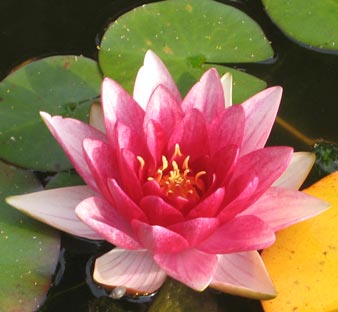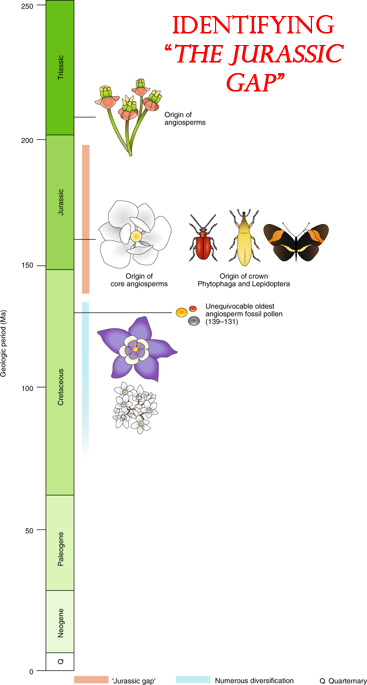The Fascinating Jurassic Angiosperm Gap
The Jurassic Angiosperm Gap
Looking at the phenomenon of the “Jurassic Gap” in today’s blog post.
Today, the flora of the world is dominated by the angiosperms (flowering plants), they are the most diverse and widespread group of land plants comprising more than four hundred families, but their origin remains a mystery. The fossil record for flowering plants is sparse, but there are numerous, unequivocal angiosperm fossils known from Cretaceous rocks.
Fossils of angiosperms from the Cretaceous appear abruptly and demonstrate a remarkable abundance of different forms. The apparently rapid evolution of flowering plants in the Cretaceous was commented upon by Charles Darwin, the author of the ground-breaking “The Origin of Species”. Darwin described the diverse Cretaceous-aged fossils of flowering plants when very few earlier flowering plant fossils were known as “a great abominable mystery.”
To read an earlier article (published in 2018), that looked at the puzzle of when angiosperms evolved: When Did Flowers First Evolve?
Fossils of Water Lilies (Nymphaeales) Are Known from the Cretaceous but when did the Flowering Plants Evolve?

Picture credit: Everything Dinosaur
Molecular Clock Dating and Genome Analyses Indicate Origins Earlier in the Mesozoic
Molecular clock studies have frequently suggested an earlier origin for angiosperms in the Jurassic, or even potentially within the Triassic. However, many studies have lacked extensive sampling, especially at the ordinal and familial levels. Now, in a new scientific paper published in the journal “Nature Plants”, researchers from the Chinese Academy of Sciences have mapped and plotted a comprehensive angiosperm phylogeny, sampling nearly 3,000 chloroplast genomes from species representing all 64 known plant Orders and 85% of all the flowering plant families described to date.
This most intensive study of living flowering plants has been cross-referenced with the fossil record of angiosperms and indicates an origin of these types of plants in the Late Triassic (around 209 million years ago – Norian stage of the Late Triassic).
This earlier age for angiosperm evolution leaves a gap between the earliest fossils and the origins of flowering plants of almost 70 million years, roughly the length of the entire Jurassic period, the authors term this huge period of geological time as “the Jurassic Gap”.
Identifying “The Jurassic Gap” in the Angiosperm Lineage

Picture credit: Nature Plants with additional annotation by Everything Dinosaur
Arising in the Late Triassic and Early Jurassic
The authors of the paper propose that the earliest lineages of flowering plants originated in the Late Triassic or Early Jurassic. These early parts of the angiosperm family tree are represented (as expected), by a few species totalling no more than a couple of hundred taxa or so. These early members of the angiosperm group include water lilies (Nymphaeales), the woody plant order Austrobaileyales, which contains star anise and the large shrub Amborella trichopoda, native to the island of New Caledonia in the southwest Pacific Ocean, a plant which is regarded as the sister taxon to the remaining angiosperms.
The data generated by the scientists indicates that major diversifications subsequently occurred in the Late Jurassic and Early Cretaceous resulting in 99.95% of the extant diversity of flowering plants. The relationships of the five major clades of this large diversification (core angiosperms) have long been difficult to determine and the researchers conclude that despite this extensive study, more work is required to resolve this aspect of flowering plant evolution.
Linked to the Rise of Insects – Symbiotic Relationships with Flowering Plants
If the first angiosperms arose in the Triassic, this corresponds with the timing of the evolution of several types of insects including katydids, crickets, alderflies and the common ancestor of the Lepidoptera (moths and butterflies). However, the spectacular diversification of core angiosperms in the Jurassic and Early Cretaceous notably also coincides with the origin and evolution of the Phytophaga, arguably the most diverse radiation of plant-feeding beetles.
Their association with angiosperms has long been proposed to account for the apparent evolutionary success of the Phytophaga. Furthermore, modern beetle diversity in general as well as other pollinators, including moths and butterflies, had their origins in the Cretaceous, which coincides with the rise of flowering plants to ecological dominance and the major diversifications of extant angiosperm diversity in the phylogeny as reported by the Chinese Academy of Sciences.
To read an article about ancient wing scales found in a drill core that suggests a Triassic origin for the Lepidoptera: Ancient Butterflies Flutter By.
Why the Jurassic Gap?
One explanation put forward for the “Jurassic Gap” is that in the early days of flowering plant evolution, these plants were rare and thus the chances of any number becoming preserved as fossils were slim. Another explanation proposed, is perhaps they occurred in habitats that were unsuitable for preservation such as forests. Charles Darwin commented that it was “wretchedly poor conjecture” that angiosperms could have had a pre-Cretaceous history on a remote, but lost, island, meaning that all evidence of early flowering plants had been essentially wiped out.
A somewhat less exotic explanation is that the structures, flowers or fruits of early flowering plants were too small to now be confidently assigned to angiosperm lineages. Perhaps, more fossils will be found to help plug the “Jurassic Gap”, but for the time being this period of seventy million years or so remains a mystery.
Everything Dinosaur acknowledges the assistance of a press release from the Chinese Academy of Sciences in the compilation of this article.
The Everything Dinosaur website: Everything Dinosaur.

